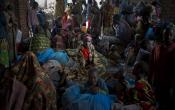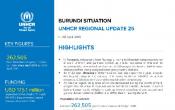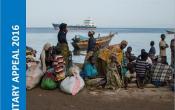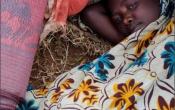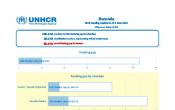Rwanda
Operation: Rwanda
Location
{"longitude":30,"latitude":-2,"zoom_level":8}
Latest update of camps and office locations 13 Jan 2016. By clicking on the icons on the map, additional information is displayed.
Key Figures
| 2015 end-year results | |
| 98% | of Congolese refugee children of primary-school age were enrolled in primary school |
| 82% | of Burundian refugee children of primary-school age were enrolled in primary school |
| 2,400 | individual resettlement submissions were made through the regional resettlement programme for Congolese (DRC) refugees, exceeding the target number of submissions |
| 99% | of Burundian refugees were registered through biometric registration during the emergency, enabling UNHCR to quickly identify and tailor assistance for people with specific needs, including unaccompanied minors |
| 97% | of deliveries were assisted by skilled health care professionals; there were 2,905 newborns in the year |
| 2016 planning figures | |
| 64% | extent to which people of concern have a valid identity document (at baseline) |
| 18.1 | average number of litres of potable water available per person per day |
| 6 | people of conern per shelter |
Latest Updates and Related Links
People of Concern
89%
Increase in
2015
2015
| 2015 | 151,173 |
| 2014 | 80,124 |
| 2013 | 81,490 |

[["Refugees",144737],["Asylum-seekers",414],["Returned refugees",5054],["Others of concern",968]]
Loading ...
Budgets and Expenditure for Rwanda
< Back
2015
{"categories":[2012,2013,2014,2015,2016],"budget":[47.03959177,46.99329576,51.77383169,123.04000345,101.37328467],"expenditure":[20.00151131,24.80532645,19.3520492,39.48045656,null]}
{"categories":[2012,2013,2014,2015,2016],"p1":[46.26031012,44.64886676,49.14538088,122.417859367,95.34220004],"p2":[null,null,null,null,null],"p3":[0.77928165,2.344429,2.62845081,0.622144083,6.03108463],"p4":[null,null,null,null,null]}
{"categories":[2012,2013,2014,2015,2016],"p1":[20.00151131,24.79354125,18.31857805,38.96277319,null],"p2":[null,null,null,null,null],"p3":[null,0.0117852,1.03347115,0.51768337,null],"p4":[null,null,null,null,null]}
Loading ...
CHOOSE A YEAR
- 2014
- 2015
- 2016
Working environment
- Rwanda is located in a region affected by ongoing tensions in the eastern Democratic Republic of the Congo (DRC) and Burundi. It has been hosting refugees for decades, while also receiving and reintegrating Rwandan returnees.
- In 2015, UNHCR focused on protecting, assisting and finding durable solutions for 74,000 Congolese (DRC) refugees hosted in Rwanda since 1996, including through a large-scale resettlement programme.
- UNHCR responded to a sudden influx of Burundian refugees fleeing electoral violence. Over 77,000 refugees, of which nearly 71,000 were still in the country at the end of 2015, were registered and assisted.
- One of the key protection issues that UNHCR faced in 2015 was the preservation of the civilian and humanitarian character of asylum.
- Other challenges included: the allocation of land in a water-scarce area to host new Burundian refugees in Mahama camp; the sudden surge in the urban refugee population (from 2,000 to 25,000); the delay in receiving funding for the Burundi response, which had a negative impact on the Congolese refugee situation; and the lack of engagement of development actors to include Congolese refugees in development programming.
Population trends
- At year end, Rwanda hosted 144,737 refugees; of these, the Congolese (DRC) refugee population remained largely stable at around 74,000, with over 2,500 departures for resettlement offset by births.
- Over 77,000 Burundian refugees were registered with UNHCR in 2015, almost 71,000 of which remained at year end.
- Following the events of 1994, over 3.3 million Rwandans who sought refuge in other countries have been returning to the country. In 2015, some 5,000 returned to Rwanda.
Achievements and impact
- Strong contingency planning and the engagement of donors and partners, including in a joint simulation exercise with government authorities, contributed to the delivery of a timely and effective response to the Burundi refugee emergency.
- Immediate engagement with the Government of Rwanda in the framework of the Refugee Coordination Model resulted in effective leadership and coordination at the capital and field level, which benefited from the strengths, expertise and capacities of partners, and helped avoid duplication.
- UNHCR’s rapid construction of Mahama camp, opened in April 2015, as well as provision of family tents for new arrivals, ensured a dignified reception of refugees from the onset of the Burundi emergency.
- UNHCR advocated the principle of non-refoulement, and borders remained open throughout 2015; moreover, the Government established the National Refugee Status Determination Committee, which began processing asylum claims.
- The operation succeeded in reducing the level of global acute malnutrition from 10 per cent in May to under 7 per cent by October 2015.
- The supply of potable water for Burundian refugees was brought within acceptable standards following the establishment of a temporary river water treatment system, which also benefitted Rwandan communities in the water-scarce area near Mahama camp.
Unmet needs
- Owing to budgetary constraints and donor fatigue, the provision of essential services to Congolese refugees in camps and urban areas, including shelter, water, sanitation and hygiene (WASH), and education, was hindered; for example, UNHCR could not support the Government of Rwanda’s education strategy for making twelve-year basic education available to all children.
- The WASH strategy, which aimed to transition completely from pit latrines to dischargeable latrines for improved hygiene, safety and dignity in camps, could not be implemented.
- Only 1,100 semi-permanent shelters were constructed to accommodate some 10,000 Burundian refugees, leaving behind 36,000 others living in deteriorating tents and communal hangars.
Working environment
The Central Africa and Great Lakes subregion is fraught with multiple conflicts and political instability. In addition to the crisis in the Central African Republic which has affected many countries in the subregion, the precarious security situation in the Democratic Republic of the Congo (DRC) has also seen large-scale refugee movements into Rwanda and other neighbouring countries.Rwanda has been hosting refugees, mainly from the DRC, but also from other African countries, for decades. The majority of the refugees are hosted in five camps – Gihembe, Kigeme, Kiziba, Mugombwa and Nyabiheke. In 2015, UNHCR will continue providing protection and assistance to refugees and asylum-seekers.
Over the past few years, thousands of refugees have returned to Rwanda and another 10,000 are expected to do so in 2015. UNHCR is active in a joint Government and One UN return and reintegration programme for Rwandan returnees, which provides a platform for all stakeholders to coordinate their activities.
With a country target of 10,000 resettled refugees, Rwanda is part of UNHCR’s regional comprehensive solutions strategy for Congolese refugees in the Great Lakes region.
The Rwandan Government makes land available for refugee camps and facilitates access for refugees to public services, particularly the educational system. To ensure that refugee students are enrolled in upper secondary education, UNHCR will support the construction of additional schools for some 4,800 students.
Needs and strategies
In 2015, issuing birth certificates to all newborns will remain a priority as currently there is a backlog of 18,000 birth certificates. Refugees aged 16 years and over will require ID cards. Machine-readable Convention Travel Documents will also be issued to refugees starting from 2015.In Rwanda, 12 years of free education for children is mandatory. A UNHCR agreement with the Government allows refugee children to enrol in the national educational system. In 2015, additional classrooms will increase the absorption capacity of local schools.
Meanwhile, problems caused by soil erosion in Gihembe camp remain a concern as there have been several tragic accidents. In all camps, soil erosion and landslides during the rainy season are a major challenge. Costly structural modifications, such as the construction of drainage systems and terracing, and the planting of trees, need to be implemented. An estimated USD 1.5 million is required to address the situation.
Regarding water, sanitation and hygiene facilities, pit latrines need to be replaced with dischargeable latrines by the end of 2015. Between 2012 and 2014, 90 latrines were constructed and 440 more are needed.
UNHCR will advocate for refugees to be enrolled into the Rwandan public health system. Local health structures need to be equipped to absorb this extra demand.
In the camps, people receive an average of just 12 litres of water per day, as the landscape and infrastructure of Gihembe and Mugombwa camps require water to be deviated from sources located approximately 15 and 28 kilometres away, respectively.

